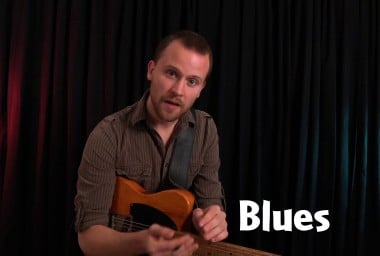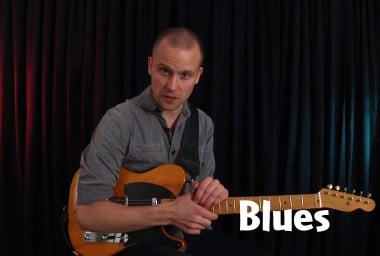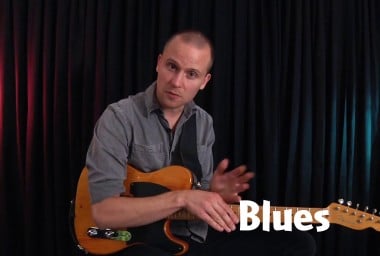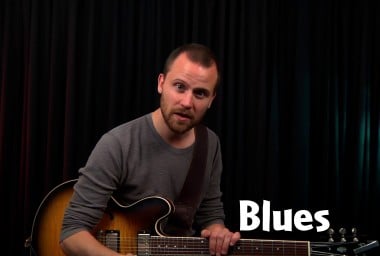Blues Style Guitar Course: Level 2
In Blues Style Course 2 we will borrow from the best by studying the playing of the three most legendary blues guitarists – “The Three Kings” B.B. King, Freddie King and Albert King. We will also cover various topics like slide-guitar, metal picks, blues-specific soloing and phrasing and get into regional blues guitar like delta, Chicago, New Orleans, Texas and even British blues. Get ready to take your blues guitar playing to the next level.
Chapter: 1: From The Crossroads: More Blues Lead
In this chapter you will expand your knowledge of blues style lead playing. You'll learn how to build your own blues licks by using the pentatonic scale and a few basic techniques like hammer-ons, pull-offs, bending and varying the rhythmic phrasing.
In this series of blues course lessons, we'll take a simple A minor pentatonic scale and explore how much music can be made with one lick. We'll break down the lick, work on making it your own, then try trading fours with a backing track!
Published: 12/13/2010 UpgradeIn this tutorial we're going to "up the ante" a bit. We'll take another blues lick that's slightly more challenging and go through a similar process as in the previous tutorial, changing the lick up and playing it along with a backing track.
Published: 12/13/2010 UpgradeIn this blues level 2 tutorial, we'll take a look at some basic building blocks to get you started on creating your own licks and building a blues vocabulary. We'll look at the importance of the root note, adding hammer-ons and pull-offs, a bend, combining these ideas, and playing them with backing tracks.
Published: 12/13/2010 UpgradeIn this second "building blocks" tutorial on blues, we'll take longer fragments of licks and how to creatively put them together. Then we'll look at how to change up the rhythm and timing, repeating notes, and other variations and play them along with a backing track. We'll also look at playing in different keys, and how the same note can be played different places on the neck.
Published: 12/13/2010 UpgradeChapter: 2: The Three Kings
In this chapter you will expand your knowledge of the Three Kings of Blues: Albert, B. B. and Freddie. You'll get a break down on the tone, phrasing and licks of each of those blues legends in order to build your own repertoire of lead fills.
In this tutorial, Anders Mouridsen will reveal some of the secrets in the style of blues legend Albert King. We'll start off with an introduction to Albert's approach, then look at his touch, tone, and use of the pentatonic "box". Next we'll examine his aggressive bending style, then break down three licks: one fill lick between vocal phrases, a typical King-style soulful lick, and a turnaround lick. We'll conclude with a jam.
Published: 08/11/2009 UpgradeB.B. King is one of the true all-time greats of the guitar; his style is synonymous with the blues! In these lessons we are going to show you some techniques and approaches in the style of B.B. King: starting off a blues tune, using space and phrasing, bending strings, the use of turnarounds, and some soloing approaches. Take these elements and work them into your own sound!
Published: 08/10/2009 UpgradeFreddie King is another essential figure in blues history, who's style has inspired many of the blues and rock greats that we know today! In this tutorial, we'll take a look at some ways that we can work some basic components of Freddie's style into our own playing by using double stops, outlining the IV and V chords, turnarounds, using a thumb pick and a metal pick on your first finger, and we'll jam with a backing track too!
Published: 08/11/2009 UpgradeChapter: 3: Creative Techniques
n this chapter you will expand your blues lead playing technique with in depth exercises on phrasing, vibrato and bending. You'll get a lot of opportunities to put that knowledge to use in practice tunes!
While it is always important to learn licks and better your soloing ability, it is also important to figure out what you want to say with those skills. This is called "phrasing," and it can take a lifetime to truly get this concept down; communicating a unique voice on the instrument. In this tutorial, we are going to teach you how you can assemble all of those licks and skills into a meaningful vocabulary on the instrument that is unique to you. Let's get started.
Published: 08/14/2009 UpgradeThe use of vibrato is an effect that is unique to all string instruments and all the more effective when used on the guitar. In blues playing, the use of vibrato is key and each blues player has his or her own vibrato. When used wisely, it can make even the simplest phrases and solos sound very effective. In this tutorial we are going to take a look at a few different types of vibrato that are both artist specific and usable by any guitarist at any level. Let's get started!
Published: 07/29/2009 UpgradeA technique unique to the guitar, bending in blues is almost as key as the 12 bar form itself. Used primarily in soloing, this technique can be explored in a variety for different to create vocal like lines and memorable hooks. We will be exploring multiple techniques with bending in this tutorial, including bending major/minor thirds, bending up one note and down another, among others. All examples are in the key of C and we will play along to some backing tracks to hear how these sound in our solos. Let's get started.
Published: 06/29/2009 UpgradeChapter: 4: More From The Crossroads
In this chapter you will expand you knowledge and skill in blues style lead playing with more conceptual and concrete skills. You'll cover using a capo, a slide hybrid picking, targeting chord tones, alternate tunings and styles.
As many techniques, scales, and chords that are used in blues music; at it's core blues was developed by players whom were self taught and played without these concepts in mind. In this tutorial, we are going examine some unique techniques and ideas that are used often by blues players. This will include using a capo, blues shredding, using your fingers to solo, along with hybrid picking techniques. All of these ideas will help you sound more authentic when playing the blues and will carry over into other areas of your playing as well. Let's get started!
Published: 07/28/2009 UpgradeIn this tutorial, we are going to examine the technique of playing chord tones in our soloing. This essentially means that we are going to solo playing only the notes in the chords we are playing over, as opposed to just running scales. This technique is very helpful in aiding the listener in hearing the chords you are playing over. This gets you out of the habit of just running scale patterns, and also helps you to sound more authentic in your soloing. In this tutorial, we will be playing these licks without a backing track and will outline the notes in our I, IV, and V chords. Let's get started.
Published: 06/29/2009 UpgradeNo matter what style of music it is, it seems as though blues works it's way into it in some way or another. When it comes to soloing, blues licks are prominent in everything from pop to metal and beyond. In this tutorial, I am going to show you how you can apply your blues licks to other styles of music. This will help see the connection and history behind the power of the blues, and work to show you how you might already have the blues in your playing already. Let's get started.
Published: 08/11/2009 UpgradeUsing a bottleneck slide is an expressive technique often used in blues. In this tutorial, we'll look at basic slide technique, open D tuning and standard tuning, some Duane Allman approaches, how to play slow blues slide, and pedal steel 3rds. We'll conclude by jamming along with a backing track.
Published: 08/10/2009 UpgradeIn this tutorial, we're going to go through six different exercises that will help improve your blues playing. First we'll do a basic pentatonic workout using alternate picking; then we'll do a hammer-on and pull-off workout. Next we'll work in grops of four, then do a triplet workout. Finally, we'll do a strumming workout and an exercise on arpeggios, using the myxolydian scale.
Published: 06/21/2011 UpgradeIn this tutorial we'll zoom out and look at the big picture of blues musicianship: improvisation, using backing tracks, playing live, and writing music. These aren't playing lessons per se, although we use a couple of backing tracks for demonstration; these lessons are intended for you to step backk and take a look at the big picture, and put your playing into a context.
Published: 06/21/2011 UpgradeChapter: 5: Rhythm, Turnarounds, and Alternative Forms
In this chapter you will learn a variety of blues style rhythm riffs and approaches. You'll take an in depth look at alternate blues forms, styles and finish with turnaround exercises from a variety of style sources.
In this tutorial we'll examine different types of basic blues rhythm riffs: the classic blues riff with triads, one and two note riffs, using "outside" triads, and a funky horn section style riff.
Published: 06/21/2011 UpgradeWhile soloing is an ever important part of playing the guitar, roughly 90% of the time as guitar players we are playing rhythm. In this tutorial, we are going to take a look some advanced rhythmic concepts and chord licks that you can use in your rhythm playing in not just blues, but in all styles. It is important to note too that you can use these skills in your soloing as well. Let's take a look.
Published: 08/10/2009 UpgradeThe "turnaround" is an essential part of playing blues of any style or region. The turnaround is essentially an end lick you play to show you are at the end of your 12 Bar Blues, and that you are ready to start the progression again. You can play this with chords, solo licks, and a wide variety of other approaches. In this tutorial, we will take a look at a few different turnarounds you can use in your blues playing to really showcase your own authenticity. Again, the turnaround really shows other players you know your blues and it also helps you to know where you are in the 12 bar form.
Published: 06/29/2009 UpgradeWe are all familiar with a 12 Bar Blues. This widely used form has crossed genres and borders into what is probably the most common musical form we are all familiar with. Although the 12 form is the dominant force in blues (among other styles), their also exists many other blues forms that are used quite often as well. In this tutorial, we will take a look at some of these varied forms and see what we can do to integrate them into our playing. This includes the 8 Bar Blues and a swing blues as well as working with other chords instead of the I, IV, and V. Let's take a look!
Published: 07/06/2009 UpgradeChapter: 6: Regional Blues Styles
In this chapter you will get more in depth about various regional blues styles. You'll learn what distinguishes old school Delta blues from uptown Chicago blues, the differences between Texas and New Orleans blues; and get an intro to jazzy blues and British flavored blues. As always, you'll get a lot of opportunities to put that knowledge to use in practice tunes!
The roots and origin of the blues language are firmly planted in the players of the Mississippi Delta area. Players such as Robert Johnson and Son House shaped the style to come and paved the way for a musical tradition that changed the entire world. The roots of almost every style of modern music can be traced back to the Delta, and our lessons today will give you an introduction to this all too important region. Using an acoustic guitar, open tunings, and a slide; let's explore this style.
Published: 06/27/2009 UpgradeThe roots of electric blues are found in the sounds of the Windy City; also known as Chicago. The sounds of Chicago Blues trace back to when migrant workers from the south moved north to bigger cities to seek employment. What they brought with them was a rich tradition of Delta blues, but than amplified that with an electric guitar along with added instrumentation. Some key players to this style include Muddy Waters, Buddy Guy, and many many more. In this tutorial, we will look at the grooves and chordal concepts of this style; focusing on rhythm guitar techniques and artist examples. Let's get started!
Published: 06/27/2009 UpgradeTexas is home to many legends of the blues such as Stevie Ray Vaughn, Lightnin' Hopkins, T-Bone Walker, and many more. In this tutorial, we will examine both the acoustic and electric sides of this style; focusing on players in the genre and their approaches to the instrument. All examples are in the key of E.
Published: 06/23/2009 UpgradeThe blues of New Orleans is most often rooted in the signature rhythms played by drums and piano. The grooves and "second line" rhythms in this style are true to the region all their own and are a mixture of many styles of music. The coming together of these styles and it's unique groove (rooted in the "clave") account for a blues style that is both unique and fun to play. While not often associated with guitar, I am going to show you in this tutorial how I would approach this style in a live situation. We will be taking licks and ideas from other instruments and applying them to the guitar to try and mock this style.
Published: 06/23/2009 UpgradeJazz, like most modern music styles, is rooted in the blues tradition. Having an understanding of Jazz Blues is a great introduction to the world of jazz and it's wide world of possibilities. In this tutorial, we will break down how to turn your standard 12 Bar Blues into a Jazz Blues via a step by step process. Each lesson will take the form a step further, introducing you to some new chords and ideas within the blues. Explore each lesson thoroughly and work to fully understand how to turn your standard blues into a Jazz Blues.
Published: 06/25/2009 UpgradeBritish Blues is a style of music that was not only important musically, but had strong social impact as well. The popularity of American blues artists such as John Lee Hooker and Muddy Waters in the U.K had a huge impact on the culture, and eventually the blues was no longer strictly a black style of music. The player with the strongest impact on the British Blues Movement of the 60's and 70's was Jon Mayall, whose band the Bluesbreakers went on to springboard the careers of Eric Clapton, Mick Taylor, and Peter Greene amongst many others. In this tutorial, we are going to take a look at these players and their influence on this ever important movement in blues history. Let's get started.
Published: 08/17/2009 Upgrade


























